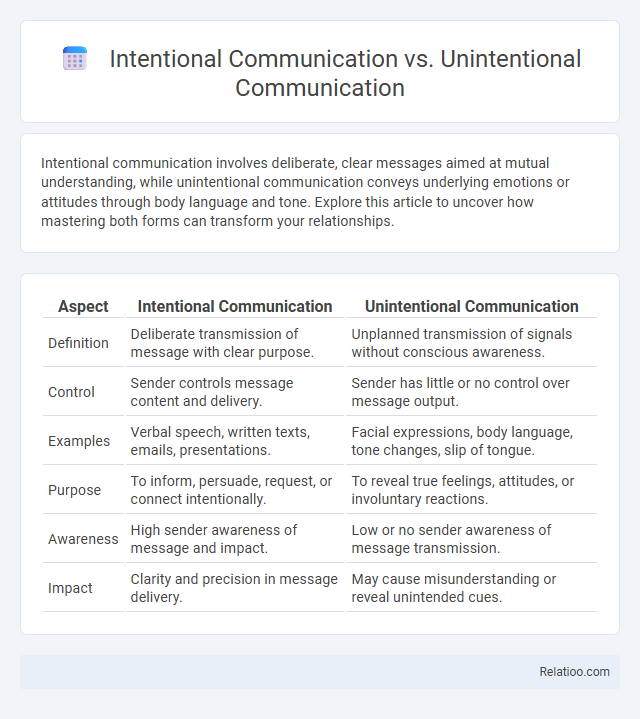Intentional communication involves deliberate, clear messages aimed at mutual understanding, while unintentional communication conveys underlying emotions or attitudes through body language and tone. Explore this article to uncover how mastering both forms can transform your relationships.
Table of Comparison
| Aspect | Intentional Communication | Unintentional Communication |
|---|---|---|
| Definition | Deliberate transmission of message with clear purpose. | Unplanned transmission of signals without conscious awareness. |
| Control | Sender controls message content and delivery. | Sender has little or no control over message output. |
| Examples | Verbal speech, written texts, emails, presentations. | Facial expressions, body language, tone changes, slip of tongue. |
| Purpose | To inform, persuade, request, or connect intentionally. | To reveal true feelings, attitudes, or involuntary reactions. |
| Awareness | High sender awareness of message and impact. | Low or no sender awareness of message transmission. |
| Impact | Clarity and precision in message delivery. | May cause misunderstanding or reveal unintended cues. |
Understanding Intentional Communication
Intentional communication involves deliberate actions designed to convey a specific message or achieve a particular outcome, distinguishing it from unintentional communication which occurs without conscious effort or purpose. Understanding intentional communication requires recognizing the sender's goals, the context of the interaction, and the use of clear verbal and non-verbal cues to ensure the message is accurately received. Intentional communication enhances clarity, reduces misunderstandings, and plays a critical role in effective interpersonal relationships and professional settings.
Defining Unintentional Communication
Unintentional communication occurs when a message is conveyed without the sender's conscious awareness or deliberate effort, such as nonverbal cues like facial expressions, posture, or tone of voice. This type of communication contrasts with intentional communication, where messages are purposefully crafted and transmitted to achieve specific outcomes. Understanding unintentional communication is crucial as it often reveals true emotions and attitudes, influencing interpersonal interactions and social dynamics beyond spoken words.
Key Differences Between Intentional and Unintentional Communication
Intentional communication involves deliberate messages conveyed with a specific purpose, where the sender is fully aware of the content and desired outcome, contrasting with unintentional communication, which occurs without conscious awareness or planned intent, often revealed through body language or spontaneous reactions. The key differences lie in the presence of conscious intent, clarity of message, and control over the communication process, with intentional communication being explicit and goal-directed, while unintentional communication is implicit and often subconscious. Understanding these distinctions enhances interpersonal effectiveness by allowing individuals to interpret meaning accurately and respond appropriately to both deliberate and inadvertent signals.
The Psychology Behind Intentional Communication
Intentional communication involves deliberate messages crafted to influence or inform, while unintentional communication conveys meaning without conscious effort, often through body language or tone. The psychology behind intentional communication highlights how your cognitive processes, emotional states, and social awareness shape the clarity and impact of your message. Understanding your intention enables effective interaction by aligning your verbal and nonverbal signals to achieve specific communicative goals.
Common Examples of Unintentional Communication
Common examples of unintentional communication include body language such as fidgeting or avoiding eye contact, which can convey nervousness or discomfort without conscious effort. Tone of voice and facial expressions often unintentionally reveal emotions like anger or sadness, influencing interpersonal interactions despite the speaker's intent. Unlike intentional communication, where messages are deliberately crafted, unintentional communication occurs subconsciously and can impact how intentions are perceived.
Impact of Intentional Communication in Relationships
Intentional communication involves deliberate and conscious messaging designed to convey specific meanings, fostering clarity and trust in relationships. Unintentional communication, often unconscious and accidental, can cause misunderstandings or mixed signals, hindering effective connection. Your ability to practice intentional communication significantly enhances emotional intimacy and conflict resolution, strengthening relationship bonds through purposeful and clear interaction.
Unintentional Communication and Its Consequences
Unintentional communication occurs when messages are conveyed without conscious awareness, often through body language, tone, or facial expressions. These nonverbal cues can lead to misunderstandings or misinterpretations, adversely affecting relationships and trust in your personal or professional interactions. Recognizing and managing unintentional communication is crucial to minimizing negative consequences and enhancing clarity in your exchanges.
Strategies to Enhance Intentional Communication
Intentional communication involves deliberate messaging with clear goals, while unintentional communication occurs without conscious planning, often revealing true feelings or attitudes; intention itself is the underlying purpose driving your interactions. Strategies to enhance intentional communication include active listening, clear and concise language, and mindful nonverbal cues, all tailored to ensure your message is understood as intended. By focusing on these techniques, you can improve relationship dynamics and reduce misunderstandings in both personal and professional contexts.
Recognizing and Addressing Unintentional Messages
Unintentional communication often occurs through body language, tone, or facial expressions that convey messages without conscious awareness, potentially leading to misunderstandings in Your interactions. Recognizing unintentional messages requires careful observation of nonverbal cues and context to distinguish them from intentional communication, which is deliberately crafted to convey specific information. Addressing these unintentional signals involves feedback and clarification to ensure accurate interpretation and strengthen overall communication effectiveness.
Building Effective Communication Skills for Clarity and Purpose
Intentional communication involves deliberately conveying messages with clear purpose, while unintentional communication occurs without conscious awareness, often leading to misunderstandings. Understanding the distinction between your intention and the actual message received is crucial for building effective communication skills. Mastering this awareness enhances clarity, ensuring your communication aligns with your desired outcomes and strengthens interpersonal connections.

Infographic: Intentional Communication vs Unintentional Communication
 relatioo.com
relatioo.com